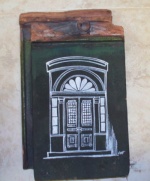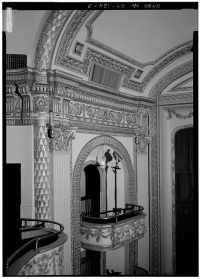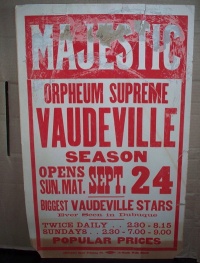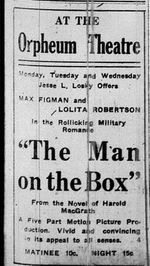Encyclopedia Dubuque
"Encyclopedia Dubuque is the online authority for all things Dubuque, written by the people who know the city best.”
Marshall Cohen—researcher and producer, CNN
Affiliated with the Local History Network of the State Historical Society of Iowa, and the Iowa Museum Association.
MAJESTIC THEATRE: Difference between revisions
No edit summary |
No edit summary |
||
| Line 1: | Line 1: | ||
[[Image:majestic.gif|left|thumb|250px|Majestic Theater]] | [[Image:majestic.gif|left|thumb|250px|Majestic Theater]] | ||
[[Image:tile.jpg|right|thumb|150px|This tile (8.5" x 14") was kilned in Holland for the roof of the Orpheum Theater. ]]MAJESTIC THEATER. | [[Image:tile.jpg|right|thumb|150px|This tile (8.5" x 14") was kilned in Holland for the roof of the Orpheum Theater. ]]MAJESTIC THEATER. The Majestic is the linear descendant of the [[ATHANAEUM]], a theater constructed in 1840 in a building constructed in 1833 at the corner of Fourth and Main. The Athanaeum gave rise to an amazing list of theaters which could have ended on April 7, 1910 when fire destroyed the renovated [[BIJOU THEATRE]]. Almost as the ashes were cooling, however, the site was developed as the first theater designed by the Chicago firm of C. W. Rapp and George Rapp, eventually the leading theater designers in the United States. (1) | ||
[[Image:majth.png|left|thumb|250px|Advertisement.]]The Majestic, built in 1910 at a cost of $90,000 in the style of Renaissance-Flemish architecture, was said to be a replica of the famous Moulin Rouge in Paris. (2) The theater was immediately popular with forty shows booked by the end of construction. (3) "Amateur Nights" were also held. When featured with the six usual vaudeville numbers and a farce by the entire company, the curtain was raised at 8:15 p.m (10) Among the stars who appeared on its stage were Ethel Barrymore and Eddie Cantor. (4) | [[Image:majth.png|left|thumb|250px|Advertisement.]]The Majestic, built in 1910 at a cost of $90,000 in the style of Renaissance-Flemish architecture, was said to be a replica of the famous Moulin Rouge in Paris. (2) The theater was immediately popular with forty shows booked by the end of construction. (3) "Amateur Nights" were also held. When featured with the six usual vaudeville numbers and a farce by the entire company, the curtain was raised at 8:15 p.m (10) Among the stars who appeared on its stage were Ethel Barrymore and Eddie Cantor. (4) | ||
Revision as of 20:29, 22 January 2018
MAJESTIC THEATER. The Majestic is the linear descendant of the ATHANAEUM, a theater constructed in 1840 in a building constructed in 1833 at the corner of Fourth and Main. The Athanaeum gave rise to an amazing list of theaters which could have ended on April 7, 1910 when fire destroyed the renovated BIJOU THEATRE. Almost as the ashes were cooling, however, the site was developed as the first theater designed by the Chicago firm of C. W. Rapp and George Rapp, eventually the leading theater designers in the United States. (1)
The Majestic, built in 1910 at a cost of $90,000 in the style of Renaissance-Flemish architecture, was said to be a replica of the famous Moulin Rouge in Paris. (2) The theater was immediately popular with forty shows booked by the end of construction. (3) "Amateur Nights" were also held. When featured with the six usual vaudeville numbers and a farce by the entire company, the curtain was raised at 8:15 p.m (10) Among the stars who appeared on its stage were Ethel Barrymore and Eddie Cantor. (4)
Motion pictures were shown at the Majestic by 1917. In June of that year the Telegraph-Herald featured a contest based on "Twenty Thousand Leagues Under the Sea." Interested children could clip a coupon from the newspaper and present it along with 15 cents to see the movie. When the movie was finished, they could write a short story on "What I Saw Through Captain Nemo's Submarine Window." Prizes were $5, $3, and $2. (5) In 1920, the facility was converted into a movie house. (6)
The building was renamed "The Spensley" in 1929. (7) Its first program was a presentation of the talking motion picture, "Rio Rita," the "audifilm" version of the famous Ziegfeld musical success. (8) Jack Dempsey, former heavy-weight champion boxer of the world, and his vaudeville act "A Roadside Razz" appeared at the theater in 1930. (9) The famous Red Grange appeared in a musical on December 31, 1930. The stage was turned into a huge cooking school with demonstrations of "ranges, refrigerators, and other culinary equipment" in 1933. (10)
In 1932 even as the U.S. economy foundered, RKO, an American film production and distribution company, began buying up theater after theater to add to its exhibition chain. RKO was formed after the Keith-Albee-Orpheum (KAO) theater chains and Joseph P. Kennedy's Film Booking Offices of America (FBO) studio were brought together under the control of the Radio Corporation of America (RCA) in October 1928. The Dubuque theater, one of many purchased, became part of the RKO film theater circuit and was renamed the RKO Orpheum around 1934. (11)
In 1961 Nicholas J. YIANNIAS was assistant manager of ASSOCIATED THEATRES which included the Orpheum Theater, GRAND THEATRE, STATE THEATRE and STRAND THEATER.

By 1969 the Orpheum along with much of the area around Lower Main Street was suffering poor economic times. The theater was scheduled for demolition as part of a fifteen-block URBAN RENEWAL project. Led by such community activists as Wayne Andrew NORMAN, Sr., a group developed the idea that private donations could be collected to renovate the theater into part of an exhibition-arts facility. The project was named for the five national flags that have flown over this area.
Looking back, the rescue of the building and its restoration took place in rapid succession. In December 1971 the fund drive was launched. With its success, architects were hired in July, 1972 to design the facility. In November 1972, the Orpheum Theater was placed on the NATIONAL REGISTER OF HISTORIC PLACES. The theater was restored in 1975, renamed the Five Flags Theater and reopened on February 28-29, 1976. With restoration, the main floor seated 322; the balcony, 357; and the boxes, 38 for a total of 717 people. The theater has been used annually for performances of the DUBUQUE SYMPHONY ORCHESTRA.
On August 17, 1976, an overwhelming 70% of the voters approved a bond referendum for the construction of the FIVE FLAGS CIVIC CENTER. Besides the arena, which covered 27,000 square feet of floor space and seats up to 4,000, the new plan called for theater support rooms, locker rooms, storage space, and administrative offices. The complex was connected to and designed to complement the restored theater. The new civic center opened its doors in 1979.
---
Sources:
1. "Theater at Fourth and Main," Online: http://fiveflagscenter.com/AboutUs/History.aspx
2. "An Idea Whose Time Had Come," Telegraph Herald, March 22, 1979, p. 25
3. Voight, Sandye. "New-Look Five Flags Shines," Telegraph Herald, October 4, 2001, p. 11
4. "Amateurs Tonight," Dubuque Telegraph-Herald, March 1, 1912, p. 11
5. Miller, Jim. "Restoring Theater 'Would Enhance Heritage,'Telegraph Herald, January 14, 1971, p. 13
6. "Children Begin Clipping Coupons For Greatest Undersea Picture," Dubuque Telegraph-Herald, June 28, 1917, p. 7
7. "Theater at Fourth and Main"
8. "New Spensley Open to the Public," Telegraph-Herald and Times Journal, November 17, 1929, p. 22
9. "Dempsey Comes Here Wednesday," Telegraph Herald and Times Journal, April 1, 1930, p. 5
10. "Make Spensley Theatre Ready for Cooking Demonstration," Telegraph Herald and Times Journal, Apr. 11, 1933, p. 5
11. "RKO Pictures," Wikipedia. Online: http://en.wikipedia.org/wiki/RKO_Pictures











